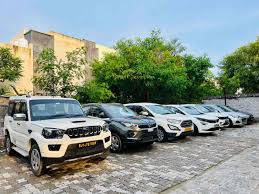Cycling Through Rajasthan: A Unique Adventure
Rajasthan, known for its rich history, vibrant culture, and breathtaking landscapes, offers a truly unique experience for those who choose to explore it by bicycle. Cycling tourism in Rajasthan is a growing trend, and it’s no surprise why—Rajasthan’s diverse terrain, ancient forts, palaces, remote villages, and scenic roads make it an ideal destination for cycling enthusiasts. Whether you're a seasoned cyclist or someone looking to experience the desert landscape at a slower pace, cycling through Rajasthan offers a perfect blend of adventure, culture, and history.
The Appeal of Cycling in Rajasthan
Rajasthan’s vast expanse of desert, dotted with majestic palaces, forts, and lush oases, presents cyclists with a wide range of experiences. From the bustling streets of Jaipur to the tranquil countryside of rural Rajasthan, cycling allows visitors to get up close and personal with the land and its people in a way that is simply impossible in a car. The sense of freedom and connection to the surroundings while pedaling through Rajasthan’s majestic landscapes is an experience like no other.
Cycling tourism in Rajasthan is also an eco-friendly way to explore the state. By riding a bike, you reduce your carbon footprint while gaining an immersive experience in the region’s culture and history. With cycling tours on offer, ranging from easy rides through serene rural landscapes to more challenging routes through rugged terrains, Rajasthan has something to offer cyclists of all skill levels.
Best Cycling Routes in Rajasthan
Jaipur – Amber Fort Loop One of the most popular cycling routes in Rajasthan is the loop between Jaipur and Amber Fort. Jaipur, the Pink City, is known for its vibrant streets, colorful markets, and historic landmarks. The route from Jaipur to Amber Fort, a journey of about 11 kilometers, takes cyclists through the city's lively streets before heading out into more peaceful countryside. As you ride, you’ll pass traditional Rajasthani homes, rural farms, and beautiful palaces like the Jal Mahal. Once at Amber Fort, cyclists are treated to panoramic views of the surrounding hills and the fort's stunning architecture.
Jaisalmer – Kuldhara Village Jaisalmer, the Golden City, is another incredible destination for cycling tours. Known for its sandstone fort, narrow alleys, and desert surroundings, Jaisalmer offers a unique desert cycling experience. A popular route is from Jaisalmer to the abandoned village of Kuldhara, located around 17 kilometers away. The ride takes you through the arid desert terrain, past wind-swept dunes and salt flats. Kuldhara is known for its eerie charm, with its ghost town appearance and historical significance. The ride itself is relatively easy and offers plenty of opportunities to spot local wildlife, such as camels and desert birds.
Udaipur – Kumbhalgarh Fort For those looking for a more challenging ride, the route from Udaipur to Kumbhalgarh Fort provides both a physical challenge and a stunning backdrop. Udaipur, known as the City of Lakes, is famous for its beautiful palaces and lakes. Cycling through the countryside towards Kumbhalgarh Fort—about 85 kilometers from Udaipur—takes cyclists through hills, valleys, and forests, with spectacular views of the Aravalli Range. Kumbhalgarh Fort, a UNESCO World Heritage site, is one of the largest forts in Rajasthan and boasts a massive wall that stretches over 36 kilometers.
Bikaner – Deshnoke (Karni Mata Temple) Another remarkable route is the ride from Bikaner to Deshnoke, home of the Karni Mata Temple, also known as the "Rat Temple." The route is about 30 kilometers long, and cyclists can experience the stunning desert terrain, dotted with camel carts and small villages. The Karni Mata Temple is famous for housing thousands of rats, which are considered sacred by the locals. This unusual site adds a touch of the mystical to the journey, and cycling through Bikaner’s expansive rural landscape provides a sense of Rajasthan’s vastness.
Pushkar – Ajmer Cycling from Pushkar to Ajmer (around 15 kilometers) is another iconic route for cyclists. Pushkar, a spiritual town known for its annual camel fair and the holy Pushkar Lake, is a popular stop for tourists. The ride to Ajmer is relatively short but picturesque, taking cyclists through the dry desert plains, interspersed with rocky hills and scenic farmland. Ajmer itself is home to the famous Ajmer Sharif Dargah, a significant pilgrimage site for people of all faiths, making it a culturally enriching stop on any cycling itinerary.
Cycling Tours and Support
Many tour operators in Rajasthan now offer organized cycling tours, catering to both beginners and experienced cyclists. These tours typically include bike rentals, route planning, accommodation, and a support crew. Guided tours are ideal for first-time cyclists in Rajasthan, as they ensure safety and provide insightful information about the region’s history and culture. Support vehicles are often available to assist cyclists, providing a backup in case of emergencies or fatigue.
For those who prefer to cycle independently, Rajasthan’s roads and routes are relatively easy to navigate, although having a local guide or map is recommended. Cycling through Rajasthan can be a little challenging due to the heat, so it is best to schedule rides during the cooler months, from October to March. Riders should be prepared for long, sunny stretches of road with limited shade, and it’s important to carry plenty of water, sunscreen, and protective gear.
The Cultural Experience of Cycling in Rajasthan
Cycling in Rajasthan offers an unparalleled opportunity to immerse yourself in the state’s rich culture. As you cycle through villages, towns, and cities, you'll encounter local traditions, colorful markets, and warm hospitality. Many cyclists choose to stop at roadside dhabas (small eateries) to sample local Rajasthani cuisine,uch as dal bati churma, s gatte ki sabzi, and sweet treats like ghewar and kalakand.
The slower pace of cycling allows for meaningful interactions with locals. You might pass rural farmers working in their fields or have the chance to chat with shopkeepers in a village market. Rajasthan’s vibrant culture, along with its welcoming people, ensures that every ride is an adventure filled with new experiences.











